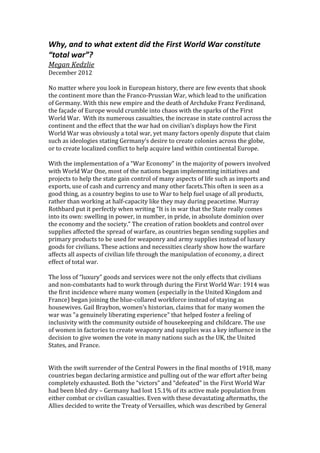
To what extent can the First World War constitute "total war"?
- 1. Why, and to what extent did the First World War constitute “total war”? Megan Kedzlie December 2012 No matter where you look in European history, there are few events that shook the continent more than the Franco-Prussian War, which lead to the unification of Germany. With this new empire and the death of Archduke Franz Ferdinand, the façade of Europe would crumble into chaos with the sparks of the First World War. With its numerous casualties, the increase in state control across the continent and the effect that the war had on civilian’s displays how the First World War was obviously a total war, yet many factors openly dispute that claim such as ideologies stating Germany’s desire to create colonies across the globe, or to create localized conflict to help acquire land within continental Europe. With the implementation of a “War Economy” in the majority of powers involved with World War One, most of the nations began implementing initiatives and projects to help the state gain control of many aspects of life such as imports and exports, use of cash and currency and many other facets.This often is seen as a good thing, as a country begins to use to War to help fuel usage of all products, rather than working at half-capacity like they may during peacetime. Murray Rothbard put it perfectly when writing “It is in war that the State really comes into its own: swelling in power, in number, in pride, in absolute dominion over the economy and the society.” The creation of ration booklets and control over supplies affected the spread of warfare, as countries began sending supplies and primary products to be used for weaponry and army supplies instead of luxury goods for civilians. These actions and necessities clearly show how the warfare affects all aspects of civilian life through the manipulation of economy, a direct effect of total war. The loss of “luxury” goods and services were not the only effects that civilians and non-combatants had to work through during the First World War: 1914 was the first incidence where many women (especially in the United Kingdom and France) began joining the blue-collared workforce instead of staying as housewives. Gail Braybon, women’s historian, claims that for many women the war was "a genuinely liberating experience" that helped foster a feeling of inclusivity with the community outside of housekeeping and childcare. The use of women in factories to create weaponry and supplies was a key influence in the decision to give women the vote in many nations such as the UK, the United States, and France. With the swift surrender of the Central Powers in the final months of 1918, many countries began declaring armistice and pulling out of the war effort after being completely exhausted. Both the “victors” and “defeated” in the First World War had been bled dry – Germany had lost 15.1% of its active male population from either combat or civilian casualties. Even with these devastating aftermaths, the Allies decided to write the Treaty of Versailles, which was described by General
- 2. Hubert Gough in 1920 as “we thought to establish a good and lasting peace which would, of necessity, have been established on good will. The Peace Treaty has done nothing of the kind.” The reparations that had been forced upon Germany and the Central Powers did nothing to help smooth the ragged edges of Europe after the conflict, and almost definitely lead to the start of Nazi Germany and eventually WWII. Even with all these views, there are still many historians who have the strong beliefs that Germany was not aiming for a large scale warfare. Even with a Kaiser who was not known for his military intelligence, it has to be said that Germany should see with their placement in the geographics of Europe, and the size of the many nations surrounding them (as unstable and imperialized as they were), there wasn’t much of a chance that an attack from Germany would come to much. Therefore we can understand the claims of Erdmann and Zechlin, who place blame in Germany, and german aim’s to create a localized, limited warfare, to help shift the balance of power in Central Europe for their own gains. Seeing though how the rest of Europe seemed to be mobilizing (Russia was moving troops while their country grew restless under revolution, and Austria-Hungary was desperately holding on to their imperial roots), it was the obvious moment for Germany to exert some sembelance of control in their localized part of Europe. While there are many points that clearly show the extent that the total war raged, we can also make the point that total warfare may not have been to aim of Germany, when they decided to mobilize against their enemies.
